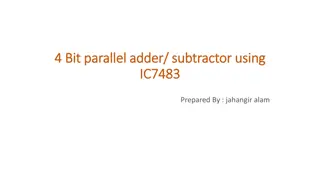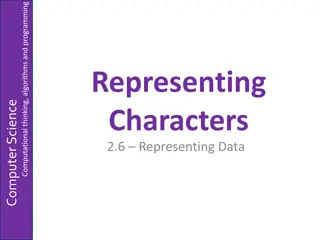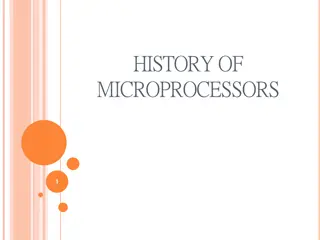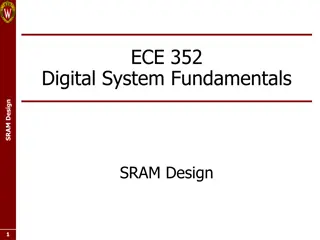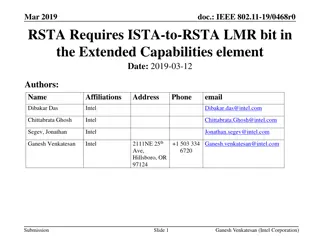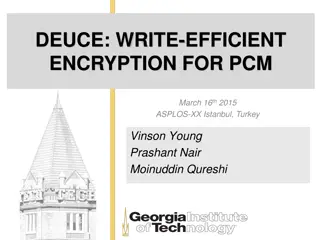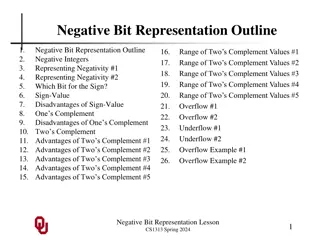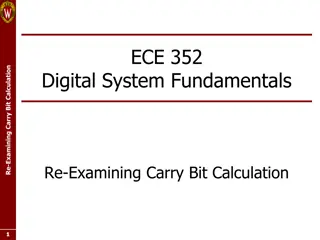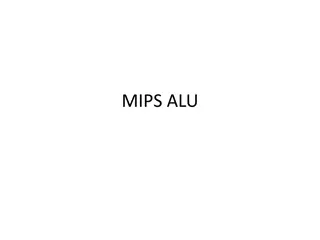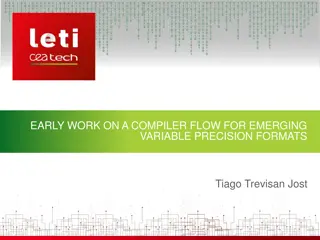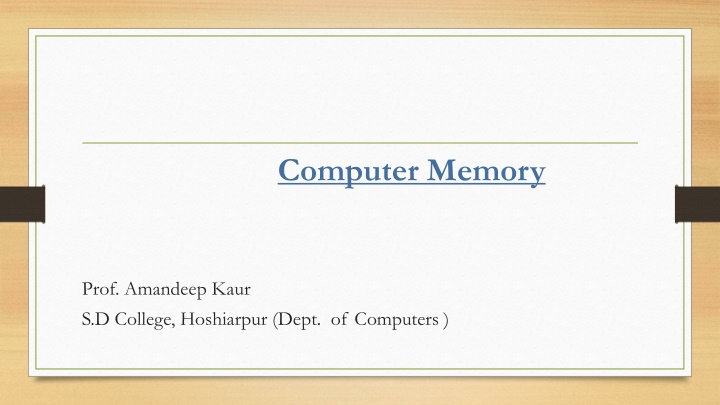
Understanding Computer Memory and Data Representation
Explore the concepts of data representation, bits, bytes, words, microprocessors, and computer memory. Learn how data is stored, processed, and transmitted in computers, and understand the significance of memory in electronic digital systems.
Download Presentation

Please find below an Image/Link to download the presentation.
The content on the website is provided AS IS for your information and personal use only. It may not be sold, licensed, or shared on other websites without obtaining consent from the author. If you encounter any issues during the download, it is possible that the publisher has removed the file from their server.
You are allowed to download the files provided on this website for personal or commercial use, subject to the condition that they are used lawfully. All files are the property of their respective owners.
The content on the website is provided AS IS for your information and personal use only. It may not be sold, licensed, or shared on other websites without obtaining consent from the author.
E N D
Presentation Transcript
Computer Memory Prof. Amandeep Kaur S.D College, Hoshiarpur (Dept. of Computers )
What is Data representation? Data Representation refers to the form in which data is stored, processed, and transmitted in computer. Computer store data in digital format i.e in the form of digits consisting of 0 and 1.
What is BIT? The bit is a basic unit of information in computing and digital communications. These values are most commonly represented as either 0or1, but other representations such as true/false, yes/no, +/ , or on/off are common.
What is BYTE? In computer systems, a unit of data that is eight binary digits long is known as a byte. A byte is the unit that computers use to represent a character such as a letter, number.
What is word? A word in Computer science is Collection of bits grouped together. It may be Consists of 16 bits, 32 bits or 64 bits. Each computer have a different word size. It totally depends upon Processor Architecture.
What is Microprocessor? A microprocessor is a computer processor that incorporates the functions of a central processing unit . The microprocessor is a multipurpose, clock driven, register based, digital integrated circuit that accepts binary data as input, processes it according to instructions stored in its memory and provides results (also in binary form) as output. Microprocessor, any of a type of miniature electronic device that contains the arithmetic, logic, and control circuitry necessary to perform the functions of a digital computer s central processing unit. In effect, this kind of integrated circuit can interpret and execute program instructions as well as handle arithmetic operations.
What is Memory? Computer memory, device that is used to store data or programs (sequences of instructions) on a temporary or permanent basis for use in an electronic digital computer.. It typically refers to semiconductor memory, specifically metal oxide semiconductor (MOS) memory, where data is stored within MOS memory cells on a silicon integrated circuit chip. Memory is an internal storage area in a computer, which is availed to store data and programs either permanently or temporarily.
Computer memory is broadly divided into two groups and they are: When the main memory holds instructions and data when a program is executing, the auxiliary memory or secondary memory holds data and programs which are not currently in use and furnishes long term storage.
The primary memory and secondary memory are further classified into distinct groups and those are explained in the below diagram:
Primary memory: Primary memory is the only type of memory which is directly accessed by the CPU. The CPU continuously reads instructions stored in the primary memory and executes them. Any data that has to be operated by the CPU is also stored. The information is transferred to various locations through the BUS. Primary memories are of two types. They are: RAM ROM RAM: It stands for Random Access Memory. Here data can be stored temporarily, so this type of memory is called as temporary memory or volatile memory because when power fails the data from RAM will be erased. The information stored in the RAM is basically loaded from the computer s disk and includes information related to the operating system and applications that are currently executed by the processor. RAM is considered random access because any memory cell can be directly accessed if its address is known. RAM is of distinct types like SRAM, DRAM, ROM: It stands for Read Only Memory. In this, the data will be furnished by the manufacturers regarding the system, so this information can simply be read by the user but cannot add new data or it cannot be modified. ROMs are of distinct types: PROM Programmable Read Only Memory EPROM Erasable Programmable Read Only Memory EEPROM Electrically Erasable Programmable Read Only Memory
Secondary Memory Secondary memory or auxiliary memory consists of slower and less expensive device that communicates indirectly with CPU via main memory. The secondary memory stores the data and keeps it even when the power fails. It is used to store or save large data or programs or other information. The secondary storage devices are explained below: Magnetic disks Magnetic tape Optical disk USB flash drive Mass storage devices
Classification of Secondary Memory. 1.Magnetic disks: Magnetic disks are made of rigid metals or synthetic plastic material. The disk platter is coated on both the surfaces with magnetic material and both the surfaces can be used for storage. The magnetic disk furnishes direct access and is for both small and large computer systems. The magnetic disk comes in two forms: Floppy disks Hard disks 2. Magnetic tape: magnetic tape is serial access storage medium and it can store a large volume of data at low costs. The conventional magnetic tape is in reels of up to 3600 feet made of Mylar plastic tape. The tape is one-half inch in width and is coated with magnetic material on one side. The reel of tape is loaded on a magnetic tape drive unit. During any read/write operation, the tape is moved from one spool to another in the same way as in the audiocassette tape recorder. The magnetic tape is densely packed with magnetic spots in frames across its width.
3. Optical drives: optical drives are a storage medium from which data is read and to which it is written by lasers. Optical disks can store much more data up to 6GB. Optical store devices are the most widely used and reliable storage devices. The most widely used type of optical storage devices are explained below: CD ROM DVD ROM CD RECORDABLE CD REWRITABLE PHOTO CD 4. USB flash drives: USB flash drives are removable, rewritable and are physically much smaller drives, which have the weight of less than 30g. In the year of 2010, the storage capacity of the USB flash drives was as large as 256GB. Such devices are a good substitute for floppy disks and CD ROMs as they are smaller, faster, have thousands of times more capacity, and are more durable and reliable. Until 2005, most desktop and laptop computers had floppy disk drives, but nowadays floppy disk drives have been abandoned in favor of USB ports. The USB connector is often protected inside a removable cap, although it is not likely to be damaged if unprotected. USB flash drives draw power from the computer through external USB connection. The most widely used USB flash drives are the memory cards. 5. Mass storage devices: Mass storage devices refer to the saving of huge data in a persistent manner. Mass storage machines can store up to several trillion bytes of data and hence are used to store or save large databases, such as the information of customers of a big retail chain and library transactions of students in a college. Some of the commonly used mass storage devices are explained below: Disk array Automated tape CD ROM jukebox


